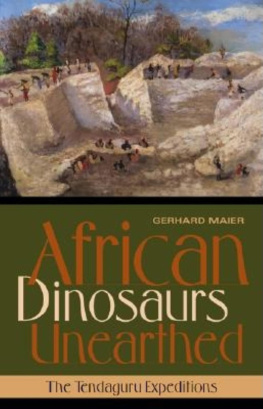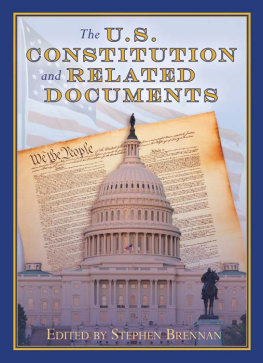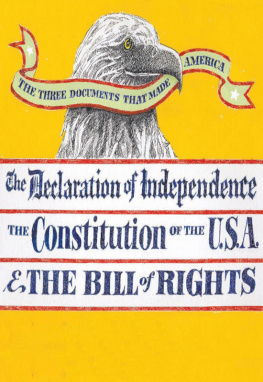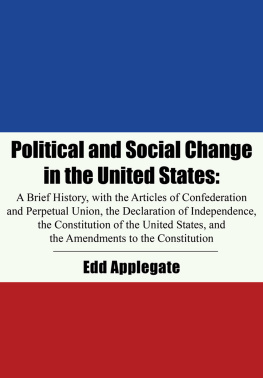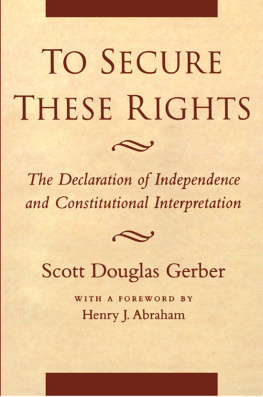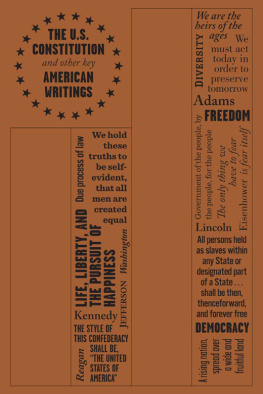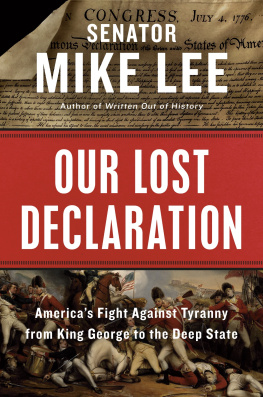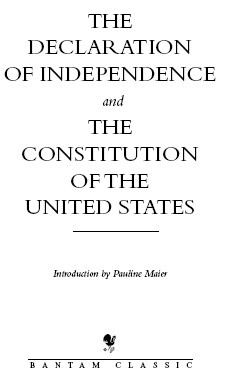Yesterday, the greatest question was decided which ever was debated in America, and a greater perhaps never was nor will be decided among men. A resolution was passed without one dissenting colony, that these United Colonies are, and of right ought to be, free and independent States.
JOHN ADAMS IN A LETTER TO ABIGAIL ADAMS [JULY 3, 1776]
That all men are by nature equally free and independent, and have certain inherent rights, of which, when they enter into a state of society, they cannot by any compact deprive or divest their posterity; namely the enjoyment of life and liberty, with the means of acquiring and possessing property, and pursuing and obtaining happiness and saftey.
GEORGE MASON, VIRGINA BILL OF RIGHTS [JUNE 12, 1776], ARTICLE I
They [the Americans] are the hope of this world. They become its model.
FROM THE LETTER OF ANNE ROBERT JACQUES TURGOT, BARON DE LAULNE TO DR. RICHARD PRICE [MARCH 22, 1778]
INTRODUCTION

THE AMERICAN TRIUMVIRATE: THE DECLARATION OF INDEPENDENCE, THE CONSTITUTION, AND THE BILL OF RIGHTS
A T THE shrine in the National Archives, just off the Mall in Washington, D.C., three parchment documents are on display. The most visible, enclosed in a heavy brass frame, standing like a tabernacle, high above the others, is the Declaration of Independence. Below it, on the surface of an altar, lie the Constitution and the federal Bill of Rights. Today the three documents seem parts of a whole; they are the founding documents of the United States, the Americans charters of freedom. Their texts have become political scriptures, in a phrase James Madison once used,1 that is, statements of belief and practice written during the American Revolution to which generation after generation of Americans has returned for guidance and direction. Over time, they came to define the Americans as a people.
The three documents were first created to perform distinct, complementary functions. The Declaration of Independence (1776) was a revolutionary manifesto that proclaimed and justified the end of British rule over America; the Bill of Rights (178991) stated the basic rights of the American people, and the Constitution (178788) created a new federal government that would, hopefully, secure those rights. Americans learned to revere documents such as these from their English ancestors, who themselves had long honored written texts such as the Magna Charta (1215), a version of which is also on display at the Archives.
One such English constitutional document, the Declaration of Rights of 168889, provided a direct precedent for all three of the documents on display at the Archives. Its opening section officially brought to an end the reign of James II, who had, it said, endeavored to Subvert and Extirpate the Protestant Religion, and the Laws and Liberties of this Kingdom by a series of acts that it listed, much as the American Declaration of Independence listed the ways in which George III had attempted to establish an absolute tyranny over these states. The second part of the English Declaration of Rights stated and declared the English peoples Ancient Rights and Liberties, as did the declarations or bills of rights that Americans wrote and attached to many state constitutions adopted between 1776 and 1780 and, later, to the federal Constitution. Finally, the English Declaration of Rights offered the British throne to James IIs daughter, Mary, and her husband, William, Prince of Orange, on the expectation that they would better protect and preserve their subjects Religion, Rights, and Liberties.2 In 1776 the Americans decided that the preservation of their liberty was incompatible with monarchy and hereditary rule. As a result, they established republics, governments in which all authority came directly or indirectly from popular choice, and whose powers and institutional structures were described in written constitutions. Those constitutions were far more elaborate than the final provisions of the English Declaration of Rights, but, like those provisions, they established a new government, or regime, that seemed more likely to preserve the peoples rights and freedom.
The affection with which Americans regard the three founding documents of the United States has not been constant over time. In the 1790s, when Madison spoke of Americas political scriptures, he referred only to constitutional charters,3 a category that included the Constitution and the Bill of Rights. The Declaration of Independencenow, as its prominence at the Archives suggests, probably the most beloved of the triumviratedid not yet belong in the category. Moreover, the federal Bill of Rights took roughly a century and a half to exert the influence that made it a powerful national icon by the late twentieth century. The functions of the Declaration of Independence and Bill of Rights also changed, and in ways that, with the Declaration in particular, have served to obscure its original function. That helps explain why so many Americans, even some in high office, persistently confuse one of the founding documents with another. It also explains why understanding those documents requires not just a careful look at their origins, but a sense of how they changed, and why, over the next two centuries.
I. THE DECLARATION OF INDEPENDENCE
Independence was something most colonists wanted to avoid. Not even the outbreak of war at Lexington and Concord, Massachusetts, on April 19, 1775, ended the Americans desire to remain under the British Crown. Delegates to the Second Continental Congress, which convened at Philadelphia on May 10, 1775, worked, as their constituents insisted, for reconciliation with the mother country and ardently denied charges that the Americans wanted to found a new empire until January 1776, when, suddenly, with the arrival of still more news that demonstrated the kings hostility toward America, the denials ceased. But even then many delegates hoped that royal peace commissioners would soon arrive and end the crisis.4
The first copies of Thomas Paines Common Sense appeared on January 9, 1776, then spread like wildfire through the country. There was no going back, the pamphlet argued; American freedom could never be secure under the British Crown. The time had come to correct the errors in Britains constitution and to found new governments free of kings and hereditary rule, governments in which all officials owed their power to popular choice. Soon not only congressional delegates, but the American people were discussing whether the time had come to found a separate American nation.
By the spring, towns, counties, and states began passing resolutions, or instructions, to their elected representatives that told them to work for independence, and frequently explained why. Sometimes the men who composed those early declarations of independence used Paines words, but seldom if ever did they repeat his central argument. In one case after another they founded their conclusion not on the flaws in Britains form of government, but on the way the king had treated Americans over the previous year. They cited George IIIs refusal even to answer the dutiful, loyal petition for peace the Congress had sent him in July 1775; his approval of the Prohibitory Act of December 1775, which made both colonial ships and ports vulnerable to attack by the Royal Navy as if they were owned by open enemies, thereby putting the Americans outside his protection his making war on his American subjects, burning American towns, including Charlestown, Massachusetts, Falmouth, Maine, and Norfolk, Virginia; his enlisting both slaves and Indians against the colonists, and, finally, in the spring of 1776, contracting with German princes for mercenary soldiers to help reestablish his authority in North America. Now a crisis was at hand: the colonists would be destroyed unless they got help from some non-British ally, which they could not do unless they bade Great Britain the last adieu. Then, as the freeholders of Buckingham County, Virginia, put it, some foreign power may, for their own interest, lend us an assisting hand.5 The decision for independence was born, in short, not of desire but of desperation.



